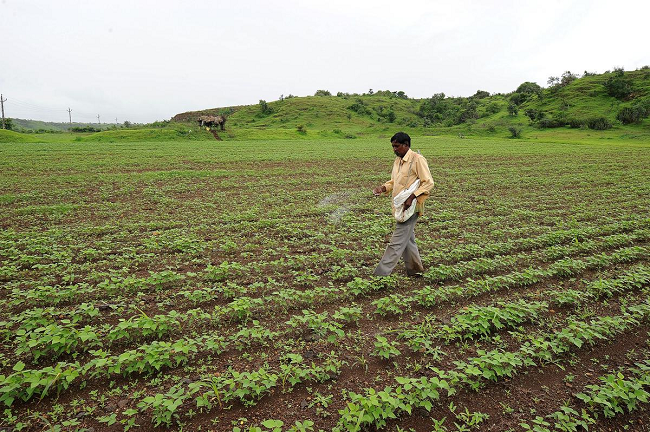
Exhibition time: 17-19 March, 2026 Shanghai, China
 中文
中文

Exhibition time: 17-19 March, 2026 Shanghai, China
 中文
中文

Key words of the passage: Nano urea; fertilizer; agriculture; farmer
‘Nano Urea’, a fertilizer patented and sold by the Indian Farmers Fertiliser Cooperative Limited (IFFCO), has been approved by the government for commercial use because of its potential to substantially reduce the import bill, but several experts have questioned the science underlying its efficacy.
Prime Minister Narendra Modi, while inaugurating a Nano Urea production plant at Kalol, Gujarat on May 28, said, “…a small bottle (500 ml) of Nano Urea is equivalent to one 50 kg bag of granular urea currently used by farmers”.
IFFCO’s Nano Urea contains nitrogen, an element critical for plant development, in the form of granules that are a hundred thousand times finer than a sheet of paper. At this ‘nano’ scale, which is about a billionth of a metre, materials behave differently than in the visible realm.
Ramesh Raliya, 34, who is credited as the inventor of Nano Urea and is now a consultant with IFFCO, told The Hindu that his process uses “organic polymers” that keeps the ‘nano’ particles of nitrogen stable and in a form that can be sprayed onto plants.
Chemically, packaged urea is 46% nitrogen, which means a 45 kg sack contains about 20 kg of nitrogen. Contrastingly, Nano Urea sold in 500 ml bottles has only 4% nitrogen (or around 20 gm). How this can compensate for the kilogrammes of nitrogen normally required puzzles scientists.
Plants need nitrogen to make protein and they source almost all of it from soil bacteria which live in a plant’s roots and have the ability to break down atmospheric nitrogen, or that from chemicals such as urea, into a form usable by plants.
To produce one tonne of wheat grain, a plant needs 25 kg of nitrogen. For rice, it’s 20 kg of nitrogen, and for maize, it’s 30 kg of nitrogen. Not all the urea cast on the soil, or sprayed on leaves in the case of Nano Urea, can be utilised by the plant. If 60% of the available nitrogen were used, it would yield 496 kg of wheat grain. Even if 100% of 20 gm of Nano Urea, which is what is effectively available, is utilised by the plant, it will yield only 368 gm of grain, said N.K. Tomar, retired Professor of Soil Science at Chaudhary Charan Singh Haryana Agriculture University, Hissar, Haryana.
“Therefore, total attempt is futile causing sheer wastage of money. This claim of IFFCO is unfounded and will be disastrous for farmers,” he notes in a letter to the NITI Aayog as well as the National Academy for Agricultural Sciences. Dr. Tomar told The Hindu they had not yet responded to his letter.
His views are seconded by I.P. Abrol, retired former Deputy Director General, Indian Council of Agricultural Research (ICAR). “Urea is highly water soluble and already reaches the lowest form of concentration when absorbed. How nanoparticles can increase the effectiveness of nitrogen uptake by being still smaller is unclear to me. That foliar spraying (spraying on leaves) improves fertilizer uptake is known for over half a century. So what’s new here?” Dr. Abrol asked.
Unlike the coarse particles that farmers normally throw onto the soil during sowing, the nano particle form of Nano Urea, when applied on to the leaves, stimulates a range of enzymes, like nitrase and nitrite reductase, which helps plants metabolise nitrogen, Dr. Raliya said.
Different parts of the plant contain nitrogen in varying proportions and because nano particles are so small and numerous, they have a lot more surface area relative to their volume, compared with the millimetre-size grains of urea that plants are exposed to — nearly 10,000 times more in nitrogen. “The interaction and metabolism is vastly improved and therefore the response (in terms of yield) is more. Take the smartphone — smaller batteries and processors are able to provide as much power as bigger batteries once did because we use nanomaterials of carbon, titanium dioxide and graphene. The quantum effects of nanoparticles and the increased surface area make the nano particles in Nano Urea deliver more nitrogen,” Dr. Raliya explained.
There are still several aspects of plant activity when exposed to nano particles that are unclear and a subject of research. “I have several research papers on this and still many questions. But we have results from experiments and that was the basis of why the product was approved by government. The farmers are benefitting from it and, ultimately, they are the best judge,” he added.
An agronomist affiliated to the Ministry of Agriculture who declined to be identified said that the increase in yields that were observed in plants which received Nano Urea was simply explained by the fact that in the first year, the nitrogen present in the soil and fertilizer was sufficient, due to which supplying nitrogen via Nano Urea was superfluous. “For example, you have money in your pocket and every year, you take a little out. At some point, you’ll run out,” he reasoned.
Dr. Raliya challenged this assertion. As part of his research work that led to the development of Nano Urea, he said he had tested if the Nano Urea was causing depletion of soil nitrogen and it wasn’t. “The amount of nitrogen in most plants is very limited, about 1%-1.5%. We saw that there was no reduction in nitrogen in the leaf, or soil,” he said.
As part of his research, there were tests done to see if Nano Urea sprayed along with organic farming methods could compensate for packaged urea. “We saw there was no loss of yield. However, you cannot wean farmers away from packaged urea overnight as these are deeply ingrained behaviours. Over the years, as farmers see results, they will themselves apply less of the packaged urea,” said Dr. Raliya, who completed his Doctoral studies at the ICAR-Central Arid Zone Research Institute, Jodhpur, and comes from a farming family.
Trilochan Mohapatra, former Director General, ICAR, during whose tenure the product was approved, told The Hindu that while the verdict on the mechanism of Nano Urea was still awaited, it was well established that much of the urea now applied on the fields was wasted. “It is fact that 70% of the urea applied today is wasted. How much of that remaining 30% actually makes it to the plant depends on a multitude of factors from how you spray to the soil quality. It’s possible that the nano particles may be aiding efficiency but proof is awaited,” Dr. Mohapatra said.
Source: The Hindu
